How to Manage GST Refunds for Export of Goods: A Complete Guide for Exporters
Exporters play a critical role in boosting the Indian economy by bringing in valuable foreign exchange. To support exporters and maintain competitiveness in international markets, the Goods and Services Tax (GST) law in India offers the benefit of zero-rated supplies. This means exporters are eligible to claim a refund of the taxes paid on input goods and services. However, many businesses still find the refund process complicated and time-consuming. In this blog, we will provide a complete guide on how to manage GST refunds for export of goods, covering key procedures, documentation, timelines, and tips for avoiding common pitfalls.
Understanding the Concept: What is a GST Refund for Exporters?
Under GST law, the export of goods is treated as a zero-rated supply. This allows exporters to claim a refund in two ways:
Export with payment of IGST: The exporter pays IGST at the time of export and claims a refund of the same.
Export under Letter of Undertaking (LUT): No IGST is paid, and the exporter claims a refund of the unutilized input tax credit (ITC).
Learning how to manage GST refunds for export of goods begins with choosing the right method that suits your business model and cash flow needs.
Eligibility Criteria for GST Refunds on Exports
To ensure you’re eligible for a GST refund on exported goods, your business must:
Be registered under GST
Have valid export invoices and shipping bills
Export goods outside India (not just between states)
File returns on time (GSTR-1 and GSTR-3B)
Being aware of these conditions is the first step in knowing how to manage GST refunds for export of goods effectively.
Step-by-Step Process: How to Manage GST Refunds for Export of Goods
Let’s break down the process into actionable steps to help exporters manage their GST refund process smoothly:
1. Choose the Export Method
Decide whether to export with IGST payment or under LUT:
With IGST: You can claim an automatic refund via the customs portal.
With LUT: You’ll need to apply for LUT on the GST portal (Form GST RFD-11) and then claim unutilized ITC as a refund.
2. File Accurate Returns
Ensure you file:
GSTR-1 with complete invoice and shipping bill details
GSTR-3B with proper declaration of zero-rated supplies
This is essential when learning how to manage GST refunds for export of goods, as mismatches between returns delay refunds.
3. Upload Export Invoices
Accurate and timely uploading of invoice and shipping bill details on the GST portal and ICEGATE portal ensures your refund application is processed without delay.
4. Submit Refund Application
If exporting under LUT, file Form GST RFD-01 on the GST portal:
Choose the tax period
Upload relevant documents
Submit the application with a digital signature
Knowing how to manage GST refunds for export of goods includes understanding the importance of correct documentation during refund claims.
Documentation Required
Keeping documents organized is a crucial part of how to manage GST refunds for export of goods. Key documents include:
Export invoices
Shipping bills / Bill of Lading / Airway bills
LUT acknowledgment (if applicable)
GSTR-1 and GSTR-3B filings
Bank realization certificates (BRCs) in some cases
Declaration or CA certificate if refund amount exceeds ₹2 lakhs
Timelines for GST Refund
Understanding timelines is critical when learning how to manage GST refunds for export of goods. Here’s what you need to know:
Refund applications must be filed within two years from the relevant date.
Refunds are typically credited within 60 days of application submission.
For IGST refunds, processing begins once both GSTR-1 and GSTR-3B are filed.
Timely filing and compliance help in avoiding interest loss due to delayed refunds.
Common Errors That Delay Refunds
When exploring how to manage GST refunds for export of goods, you must be aware of mistakes that commonly delay refund processing:
Mismatch between invoice details in GSTR-1 and shipping bill
Incorrect bank account details
Not filing LUT on time
Claiming refund without proper ITC reconciliation
Submitting incomplete or incorrect refund application
Avoiding these errors is a key part of knowing how to manage GST refunds for export of goods efficiently.
Practical Tips to Simplify Refund Management
Reconcile monthly: Regularly reconcile input tax credit, export invoices, and return filings.
Use GST-compliant software: Automate data entry and error checking using GST software tools.
Keep backups: Maintain a digital archive of all invoices, shipping documents, and LUTs.
Consult professionals: If you are unsure about eligibility or documentation, take professional advice to avoid litigation or delays.
Monitor refund status: Use the GST portal and ICEGATE to monitor the refund application status actively.
By following these practices, exporters can streamline how to manage GST refunds for export of goods.
Recent Developments in GST Refund for Exports
Keeping up with policy changes is essential to stay current on how to manage GST refunds for export of goods. Some recent changes include:
Restriction on claiming refund of ITC on capital goods under LUT exports
Scrutiny of inverted duty structure refunds
Mandatory Aadhaar authentication for refund claims
Online tracking of refund status through the GST portal
These changes aim to simplify the refund process but require exporters to be proactive in their compliance efforts.
Conclusion
Knowing how to manage GST refunds for export of goods is not just about following a few steps—it’s about integrating smart compliance into your export process. By understanding eligibility, choosing the right refund route, maintaining accurate documentation, and filing returns on time, you can ensure that your working capital is not blocked and your refund claims are processed efficiently.
With proper knowledge and proactive practices, exporters can transform the refund process from a challenge into an opportunity for financial efficiency.
Our GST Services

All E-commerce Tax services
E-commerce tax services help online sellers navigate GST registration, compliance, return filing, TCS management, tax planning, and audits, ensuring efficient tax management and legal compliance.

GST Filing
GST filing is the process of submitting tax returns to the government, detailing sales, purchases, and taxes paid or collected, ensuring compliance with GST laws.

GST Registration
GST registration is the process where businesses obtain a GSTIN from the government, allowing them to collect taxes, claim input tax credits, and comply with GST laws.





